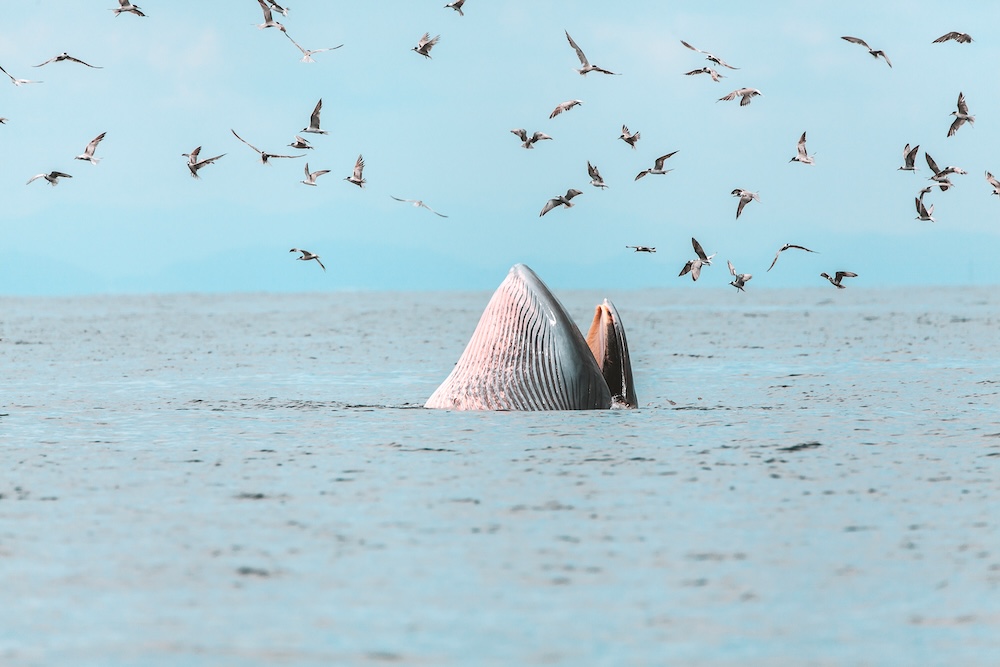In the warm, tropical waters of the Gulf of Thailand, a small, isolated population of Bryde’s whales lives on the edge of extinction. These sleek, fast-moving baleen whales, named after Norwegian whaler Johan Bryde, are a rare sight — and in this part of the world, they are rarer still.
Unlike some whale species that migrate across vast oceans, the Bryde’s whales of the Gulf remain year-round, confined to a region heavily dominated by human activity. Unfortunately, their home is also one of the busiest maritime zones in Southeast Asia, where survival is a daily gamble against the steel hulls of massive ships and the relentless pressure of industrial fishing.
Life at the Surface, Danger Below
Bryde’s whales are surface feeders, often skimming the ocean’s top layer for schools of sardines and anchovies. This feeding behavior — breathtaking to witness — puts them squarely in harm’s way. Ships traveling to and from Bangkok’s bustling ports pass through the same feeding grounds, creating a constant risk of lethal strikes.
In collisions between vessels and whales, size and speed dictate survival — and for whales, the odds are grim. A single strike from a large cargo ship can cause internal injuries, broken bones, or death, often without the ship’s crew even realizing an impact has occurred.
A Population on the Brink
Scientists estimate that the Bryde’s whale population in the Gulf of Thailand may number only in the dozens. This small, localized group has no fallback population elsewhere — their loss here would mean a total collapse of this unique genetic lineage.
The threats extend beyond direct strikes:
- Fishing Gear Entanglement
Large-scale fishing operations crisscross the Gulf with nets, lines, and gear. Whales caught in these can drown or suffer debilitating injuries. - Noise Pollution
Heavy maritime traffic creates a near-constant underwater roar. This noise disrupts communication, navigation, and feeding — vital behaviors for a species already under stress. - Declining Prey
Overfishing reduces the abundance of the small schooling fish Bryde’s whales depend on, forcing them to compete with industrial fleets for dwindling resources.
No Safety Net in Policy
Unlike certain whale habitats in the United States or Australia, the Gulf of Thailand has no mandatory slow-speed zones or rerouting measures to reduce the risk of strikes. Ships often travel at high speed through known whale areas, even during peak feeding seasons.
While marine protected areas exist on paper, they do little to address vessel speed or fishing intensity — the two most pressing threats to these whales. Enforcement is minimal, and existing regulations tend to prioritize economic throughput over ecological protection.
Why Their Survival Matters
Bryde’s whales play a critical role in the Gulf’s marine ecosystem. By feeding at the surface and diving deep, they help cycle nutrients through the water column, supporting the productivity of fish populations and phytoplankton — the microscopic plants that generate much of the oxygen we breathe.
Their presence is also an indicator of ocean health. A thriving Bryde’s whale population signals a balanced food web and a functioning marine ecosystem. Their decline is a warning that the Gulf is tipping toward ecological collapse.
What Can Be Done
Protecting the Gulf’s Bryde’s whales is possible — but it requires action now:
- Implement Mandatory Slow-Speed Zones in high-use whale areas, particularly near known feeding grounds.
- Reroute Major Shipping Lanes away from core whale habitats.
- Enhance Monitoring with aerial surveys, acoustic listening devices, and satellite tracking to identify whale locations in real time.
- Enforce Sustainable Fishing Limits to protect the prey base and reduce competition.
- Increase Public Awareness so that Bryde’s whales become a recognized national conservation priority in Thailand.
Final Thoughts
The Gulf of Thailand should be a sanctuary for its resident Bryde’s whales — a place where they can feed, socialize, and raise calves without the constant threat of steel hulls or choking nets. Instead, their habitat has become a dangerous crossroads for global shipping and industrial fishing, with no meaningful protections in place.
If Thailand chooses to act now, this unique whale population can still recover and thrive. But without urgent change, these waters may soon fall silent, and the loss will not only be measured in whales gone — it will be measured in a diminished ocean for all who depend on it.










Reader Interactions